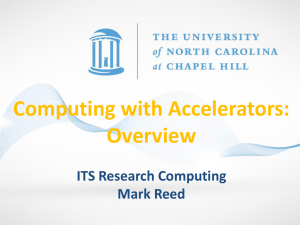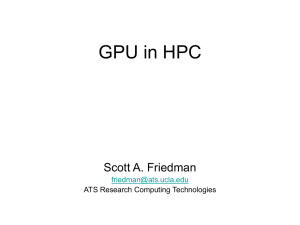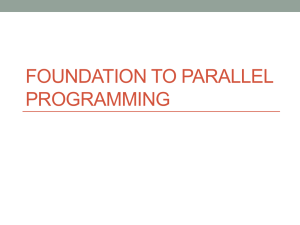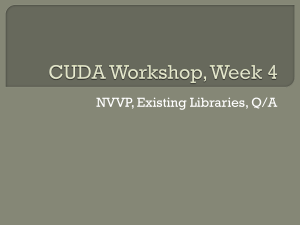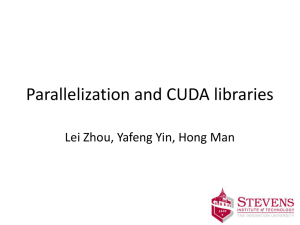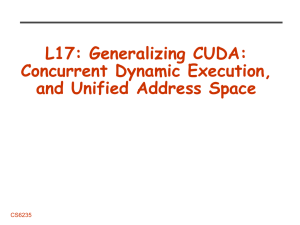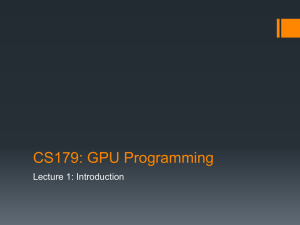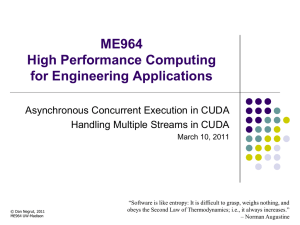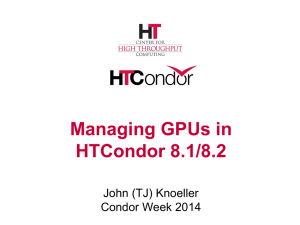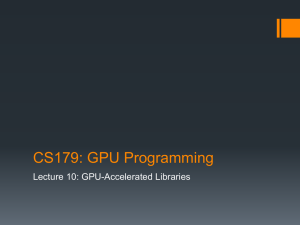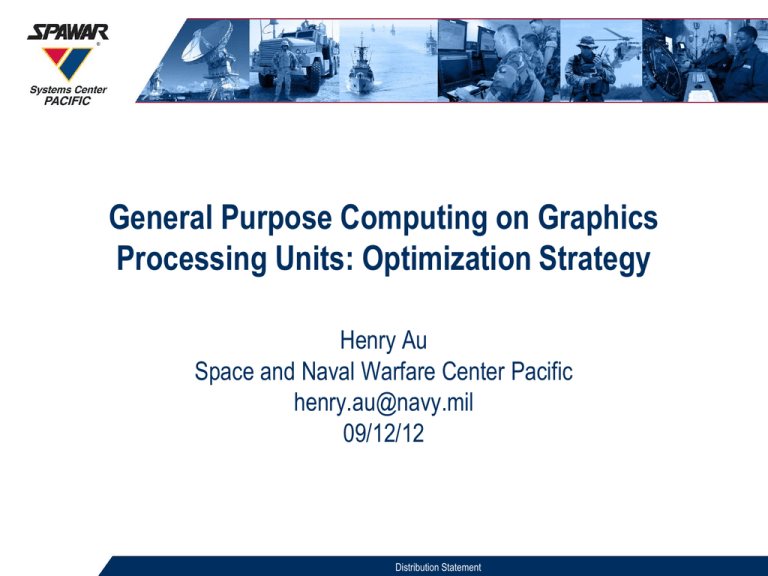
General Purpose Computing on Graphics
Processing Units: Optimization Strategy
Henry Au
Space and Naval Warfare Center Pacific
henry.au@navy.mil
09/12/12
Distribution Statement
Outline
▼ Background
▼ NVIDIA’s CUDA
▼ Decomposition & Porting
▼ CUDA Optimizations
▼ GPU Results
▼ Conclusion
9/12/12
2
Background
▼ Parallel Programming on GPUs
General-Purpose Computation on
Graphics Processing Units (GPGPU)
Compute Unified Device Architecture
(CUDA)
Open Computing Language
(OpenCLTM)
9/12/12
3
Background
▼ GPUs vs. CPUs
GPU and CPU cores not the same
CPU core is faster and more robust but, fewer cores
GPU not as robust nor fast, but handles repetitive tasks quickly
▼ NVIDIA GeForce GTX 470
448 cores
Memory Bandwidth = 133.9 GB/sec
544.32 GFLOPS DP
▼ Intel Core i7-965
4 cores
Memory Bandwidth = 25.6 GB/sec
69.23 GFLOPS DP
9/12/12
4
CUDA by NVIDIA
▼ Compute Unified Device Architecture
9/12/12
Low and High Level API available
C for CUDA
High latency memory transfers
Limited Cache
Scalable programming model
Requires NVIDIA graphics cards
5
Decomposition and Porting
▼ Amdhal’s and Gustafson’s Law
▼ Estimate Speed Up
P amount of parallel scaling achieved
γ is the fraction of algorithm that is serial
9/12/12
6
Decomposition and Porting
▼ TAU Profile
Determine call paths and consider subroutine calls
Pay attention to large for loops or redundant computations
▼ Visual Studio 2008
Initialize Profile: TAU_PROFILE(“StartFor”, “Main”, TAU_USER);
Place Timers:
− TAU_START(“FunctionName”)
− TAU_STOP(“FunctionName”)
9/12/12
7
Decomposition and Porting
▼ CUDA Overhead
High latency associated with memory transfers
Can be hidden with large amounts of mathematical computations
Reduce Device to Host memory transfers
− Many small transfers vs. fewer but larger transfers
− Perform serial tasks using parallel processors
9/12/12
8
CUDA Optimizations
▼ Thread and Block Occupancy
Varies depending on graphics card
▼ Page Locked Memory
cudaHostAlloc()
Limited resource and should not be overused
▼ Streams
A queue of GPU operations
Such as GPU computation “kernels” and memory copies
▼ Asynchronous Memory Calls
Ensure non-blocking calls
cudaMemcpyAsync() or kernel call
9/12/12
9
Thread Occupancy
▼ Ensure enough threads are operating at the same time
256 threads per block
Max 1024 threads per block
Monitor occupancy
ALF Threads Per Block vs Frames Per Second
90
85
ALF Frames Per Second Processed
64
144
196
256
324
80
400
36
75
1024
484
576
16
70
65
ALF FPS
60
55
50
4
45
40
0
200
400
600
800
1000
1200
Threads Per Block
9/12/12
10
CUDA Optimizations
▼ Page Locked Host Memory
cudaHostAlloc() vs. malloc vs. new
Processing Time Vs. Mega Bytes Data Processed
14
12
Processing Time (ms)
10
8
New
Malloc
cudaHostAlloc
6
4
2
0
0
2
4
6
8
10
12
14
Data (MB)
9/12/12
11
CUDA Optimizations
▼ Stream Structure Non-Optimized
Processing time: 49.5ms
cudaMemcpyAsync(dataA0, stream0, HostToDevice)
cudaMemcpyAsync(dataB0, stream0, HostToDevice)
kernel<<< blocks, threads, stream0>>>(result0, dataA0, dataB0)
cudaMemcpyAsync(result0, stream0, DeviceToHost)
cudaMemcpyAsync(dataA1, stream1, HostToDevice)
cudaMemcpyAsync(dataB1, stream1, HostToDevice)
kernel<<<blocks, threads, stream1>>>(result1, dataA1, dataB1)
cudaMemcpyAsync(result1, stream1, DeviceToHost)
9/12/12
12
CUDA Optimizations
▼ Stream Structure Optimized
Processing time: 49.4ms
cudaMemcpyAsync(dataA0, stream0, HostToDevice)
cudaMemcpyAsync(dataA1, stream1, HostToDevice)
cudaMemcpyAsync(dataB0, stream0, HostToDevice)
cudaMemcpyAsync(dataB1, stream1, HostToDevice)
kernel<<< blocks, threads, stream0>>>(result0, dataA0, dataB0)
kernel<<<blocks, threads, stream1>>>(result1, dataA1, dataB1)
cudaMemcpyAsync(result0, stream0, DeviceToHost)
cudaMemcpyAsync(result1, stream1, DeviceToHost)
9/12/12
13
CUDA Optimizations
▼ Stream Structure Optimized & Modified
Processing time: 41.1ms
cudaMemcpyAsync(dataA0, stream0, HostToDevice)
cudaMemcpyAsync(dataA1, stream1, HostToDevice)
cudaMemcpyAsync(dataB0, stream0, HostToDevice)
cudaMemcpyAsync(dataB1, stream1, HostToDevice)
kernel<<< blocks, threads, stream0>>>(result0, dataA0, dataB0)
cudaMemcpyAsync(result0, stream0, DeviceToHost)
kernel<<<blocks, threads, stream1>>>(result1, dataA1, dataB1)
cudaMemcpyAsync(result1, stream1, DeviceToHost)
9/12/12
14
CUDA Optimizations
▼ Stream Structure not always beneficial
Overhead could result in performance reduction
Profile to determine kernel execution vs. data transfer
− NVIDIA Visual Profiler
− cudaEventRecord()
9/12/12
15
GPU Results
▼ Optimization Stages
0: No Optimizations
1: Page Locking Memory
2: Asynchronous GPU calls
3: Non-optimized Streaming
4: Optimized Streaming
(65 FPS)
(67 FPS)
(81 FPS)
(82 FPS)
(85 FPS)
ALF Processing Speed (Frames Per Second) vs. Optimization Stage
90.00
4, 85.51
Processing Speed (FPS)
85.00
3, 82.88
2, 81.74
80.00
75.00
FPS
70.00
1, 67.05
65.00
0, 65.14
60.00
0
1
2
3
4
5
Optimization Stage
9/12/12
16
GPU Results
▼ ALF CPU vs. GPU Processing
Adaptive Linear Filter FPS Processing Vs. Image Height
100.00
624, 92.78
90.00
720, 85.51
80.00
624, 77.64
Frames Per Second
70.00
720, 67.78
60.00
CPU FPS
50.00
GPU GPS
40.00
1248, 31.95
30.00
1440, 26.13
1248, 20.05
20.00
1872, 15.23
2160, 12.91
1440, 17.07
10.00
1872, 8.92
0.00
500
700
900
1100
1300
1500
1700
1900
2160, 7.59
2100
2300
Image Height (4:3 Aspect)
9/12/12
17
Conclusion
▼ Test various thread per block allocations
▼ Use page locked memory for data transfers
Asynchronous memory transfer and non-blocking calls
▼ Ensure proper coordination of streams
Data Parallelism and Task Parallelism
9/12/12
18
QUESTIONS?
9/12/12
19
References
▼ Amdahl, G., "Validity of the single processor approach to
▼
▼
▼
▼
▼
9/12/12
achieving large scale computing capabilities." AFIPS Spring
Joint Computer Conference, 1976.
CUDA C Best Practices Guide Ver 4.0, 5/2011.
Gustafson, J., "Reevaluating Amdahl's Law." Communications
of the ACM, Vol. 31 Number 5, May 1988.
Jason Sanders, Edward Kandrot. CUDA By Example, An
Introduction to General-Purpose GPU Programming. AddisonWesley. Copyright NVIDIA Corporation 2011.
NVIDIA CUDA Programming Guide Ver 4.0, 5/6/2011.
Tau-User Guide. Department of Computer and Information
Science, University of Oregon Advanced Computing
Laboratory. 2011
20

